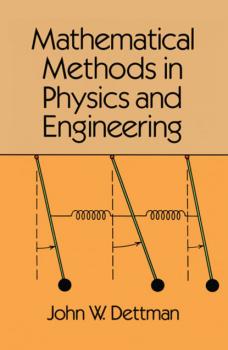ТОП просматриваемых книг сайта:
Dover Books on Physics
Скачать книги из серии Dover Books on PhysicsАннотация
An accessible exposition of gravitation theory and celestial mechanics, this classic, oft-cited work was written by a distinguished Soviet astronomer. It explains with exceptional clarity the methods used by physicists in studying celestial phenomena.A historical introduction explains the Ptolemaic view of planetary motion and its displacement by the studies of Copernicus, Kepler, and Newton. Succeeding chapters examine the making of celestial observations and measurements and explain such central concepts as the ecliptic, the orbital plane, the two- and three-body problems, and perturbed motion. Ryabov also describes how perturbations in the path of Uranus led to the discovery of Neptune, and he devotes considerable attention to satellites, including a detailed treatment of the first artificial satellite, Sputnik I. Additional topics include planetary rotation, the calculation of units of time, and the motions of the stars, with illustrations of how the law of gravity determines the shapes of galaxies. The book concludes with a deeper consideration of gravity, pointing out basic distinctions between classical and Einsteinian theories.
Аннотация
Albert Einstein characterized the work of James Clerk Maxwell as the «most profound and the most fruitful that physics has experienced since the time of Newton.» Max Planck went even further, declaring that «he achieved greatness unequalled,» and Richard Feynman asserted that «From a long view of the history of mankind — seen from, say, ten thousand years from now — there can be little doubt that the most significant event of the nineteenth century will be judged as Maxwell's discovery of the laws of electrodynamics.» Maxwell made numerous other contributions to the advancement of science, but the greatest work of his life was devoted to electricity. An Elementary Treatise on Electricity appeared at a time when very few books on electrical measurements were available to students, and its compact treatment not only elucidates the theory of electricity but also serves to develop electrical ideas in readers' minds. The author describes experiments that demonstrate the principal facts relating an electric charge as a quantity capable of being measured, deductions from these facts, and the exhibition of electrical phenomena.This volume, published posthumously from Maxwell's lecture notes at the Cavendish Laboratory — which he founded at the University of Cambridge — is supplemented by a selection of articles from his landmark book, Electricity and Magnetism. A classic of science, this volume is an eminently suitable text for upper-level undergraduates and graduate students.
Аннотация
How do we know that molecules really exist? An important clue came from Brownian movement, a concept developed in 1827 by botanist Robert Brown, who noticed that tiny objects like pollen grains shook and moved erratically when viewed under a microscope. Nearly 80 years later, in 1905, Albert Einstein explained this «Brownian motion» as the result of bombardment by molecules. Einstein offered a quantitative explanation by mathematically estimating the average distance covered by the particles over time as a result of molecular bombardment. Four years later, Jean Baptiste Perrin wrote Brownian Movement and Molecular Reality, a work that explains his painstaking measurements of the displacements of particles of a resin suspended in water — experiments that yielded average displacements in excellent accord with Einstein's theoretical prediction.The studies of Einstein and Perrin provided some of the first concrete evidence for the existence of molecules. Perrin, whose name is familiar to all who employ his methods for calculations in molecular dynamics, received the 1926 Nobel Prize in physics. In this classic paper, he introduced the concept of Avogadro's number, along with other groundbreaking work. Originally published in the French journal Annates de chimie et de physique, it was translated into English by Frederick Soddy to enduring influence and acclaim.
Аннотация
This treatment of the branch of fluid mechanics known as hypersonic inviscid flow offers a self-contained, unified view of nonequilibrium effects, body geometries, and similitudes available in hypersonic flow and thin shock layer theory. Seeking to cultivate readers' appreciation of theory, the text avoids empirical approaches and focuses on basic theory and related fundamental concepts.Contents include introductory materials and chapters on small-disturbance theory, Newtonian theory, constant-density solutions, the theory of thin shock layers, numerical methods for blunt-body flows, and other methods for locally supersonic flows.Geared toward the needs of students and researchers in the field of modern gas dynamics and those of hypersonic aerodynamics, this text is appropriate for graduate-level courses in hyspersonic flow theory as well as courses dealing with compressible flow.
Аннотация
A modern classic, this clearly written, incisive textbook provides a comprehensive, detailed survey of the functions of mathematical physics, a field of study straddling the somewhat artificial boundary between pure and applied mathematics.In the 18th and 19th centuries, the theorists who devoted themselves to this field — pioneers such as Gauss, Euler, Fourier, Legendre, and Bessel — were searching for mathematical solutions to physical problems. Today, although most of the functions have practical applications, in areas ranging from the quantum-theoretical model of the atom to the vibrating membrane, some, such as those related to the theory of discontinuous groups, still remain of purely mathematical interest.Chapters One and Two examine orthogonal polynomials, with sections on such topics as the recurrence formula, the Christoffel-Darboux formula, the Weierstrass approximation theorem, and the application of Hermite polynomials to quantum mechanics.Chapter Three is devoted to the principal properties of the gamma function, including asymptotic expansions and Mellin-Barnes integrals. Chapter Four covers hypergeometric functions, including a review of linear differential equations with regular singular points, and a general method for finding integral representations.Chapters Five and Six are concerned with the Legendre functions and their use in the solutions of Laplace's equation in spherical coordinates, as well as problems in an n-dimension setting. Chapter Seven deals with confluent hypergeometric functions, and Chapter Eight examines, at length, the most important of these — the Bessel functions. Chapter Nine covers Hill's equations, including the expansion theorems.
Аннотация
This excellent text, directed to upper-level undergraduates and graduate students in engineering and applied physics, introduces the fundamentals of quantum mechanics, emphasizing those aspects of quantum mechanics and quantum statistics essential to an understanding of solid-state theory. A heavy background in mathematics and physics is not required beyond basic courses in calculus, differential equations, and calculus-based elementary physics.The first three chapters introduce quantum mechanics (using the Schrödinger equations), quantum statistics, and the free-electron theory of metals. Chapters 4 and 5 deal with the WKB approximation and perturbation theory. Chapters 6 and 7 focus on the periodic potential of a crystalline solid and electronic energy bands.To increase the effectiveness of the material as a learning aid, all developments are carefully worked out, complete details are given for each of the derivations, and successive derivations are developed on a firm basis provided by the preceding material. Throughout the text, examples from solid-state physics illustrate specific applications and demonstrate the principal results that can be deduced by means of quantum theory. Numerous problems (with selected answers), projects, and exercises have been incorporated to facilitate mastery of the text material.
Аннотация
Intended for college-level physics, engineering, or mathematics students, this volume offers an algebraically based approach to various topics in applied math. It is accessible to undergraduates with a good course in calculus which includes infinite series and uniform convergence. Exercises follow each chapter to test the student's grasp of the material; however, the author has also included exercises that extend the results to new situations and lay the groundwork for new concepts to be introduced later. A list of references for further reading will be found at the end of each chapter. For this second revised edition, Professor Dettman included a new section on generalized functions to help explain the use of the Dirac delta function in connection with Green's functions. In addition, a new approach to series solutions of ordinary differential equations has made the treatment independent of complex variable theory. This means that the first six chapters can be grasped without prior knowledge of complex variables. However, since Chapter 8 depends heavily on analytic functions of a complex variable, a new Chapter 7 on analytic function theory has been written.
Аннотация
The republication of this book, unabridged and corrected, fills the need for a comprehensive work on fundamental formulas of mathematical physics. It ranges from simple operations to highly sophisticated ones, all presented most lucidly with terms carefully defined and formulas given completely. In addition to basic physics, pertinent areas of chemistry, astronomy, meteorology, biology, and electronics are also included.This is no mere listing of formulas, however. Mathematics is integrated into text, for the most part, so that each chapter stands as a brief summary or even short textbook of the field represented. The book, therefore, fills other needs than the primary function of reference and guide for research. The student will find it a handy review of familiar fields and an aid to gaining rapid insight into the techniques of new ones.The teacher will study it as a useful guide to a broad concept of physics. The chemist, astronomer, meteorologist, biologist, and engineer will not only derive valuable aid from their special chapters, but will understand how their specialty fits into the large scheme of physics.Vol. 1 chapter titles: Basic Mathematical Formulas, Statistics, Nomograms, Physical Constants, Classical Mechanics, Special Theory of Relativity, The General Theory of Relativity, Hydrodynamics and Aerodynamics, Boundary Value Problems in Mathematical Physics, Heat and Thermodynamics, Statistical Mechanics, Kinetic Theory of Gases: Viscosity, Thermal Conduction, and Diffusion, Electromagnetic Theory, Electronics, Sound and Acoustics.Vol. 2 chapter titles: Geometrical Optics, Physical Optics, Electron Optics, Molecular Spectra, Atomic Spectra, Quantum Mechanics, Nuclear Theory, Cosmic Rays and High-Energy Phenomena, Particle Accelerators, Solid State, Theory of Magnetism, Physical Chemistry, Basic Formulas of Astrophysics, Celestial Mechanics, Meteorology, Biophysics.








